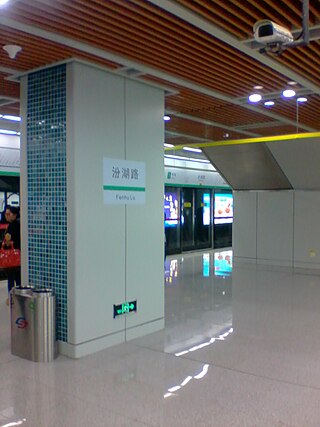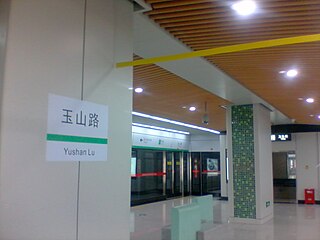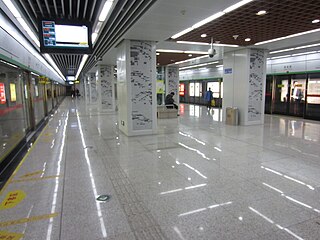
A low-floor bus is a bus or trolleybus that has no steps between the ground and the floor of the bus at one or more entrances, and low floor for part or all of the passenger cabin. A bus with a partial low floor may also be referred to as a low-entry bus or seldom a flat-floor bus in some locations.

A wheelchair ramp is an inclined plane installed in addition to or instead of stairs. Ramps permit wheelchair users, as well as people pushing strollers, carts, or other wheeled objects, to more easily access a building, or navigate between areas of different height. Ramps for accessibility may predate the wheelchair and are found in ancient Greece.

A wheelchair-accessible van is a vehicle that has been modified by increasing the interior size of the vehicle and equipping it with a means of wheelchair entry, such as a wheelchair ramp or powered lift.

A stair lift is a mechanical device for lifting people, typically those with disabilities, up and down stairs. For sufficiently wide stairs, a rail is mounted to the treads of the stairs. A chair or lifting platform is attached to the rail. A person gets onto the chair or platform and is lifted up or down the stairs by the chair which moves along the rail.

Tactile paving is a system of textured ground surface indicators found at roadsides, by and on stairs, and on railway station platforms, to assist pedestrians who are vision impaired.
Accessibility for people with disabilities on the Toronto Transit Commission (TTC) system is incomplete but improving. Most of the Toronto subway system was built before wheelchair access was a requirement under the Ontarians with Disabilities Act (ODA). However, all subway stations built since 1996 are equipped with elevators, and elevators have been installed in 44 stations built before 1996. Over 75 percent of Toronto's subway stations are accessible. The original plan was to make all stations accessible by 2025; however, a few stations might not be accessible until 2026.

A wheelchair is a chair with wheels, used when walking is difficult or impossible due to illness, injury, problems related to old age, or disability.

High-floor describes the interior flooring of commuter vehicles primarily used in public transport such as trains, light rail cars and other rail vehicles, along with buses and trolleybuses. Interior floor height is generally measured above the street surface or above the top of the rail. High-floor designs usually result from packaging requirements: mechanical items such as axles, motors, crankshafts, and/or transmissions, or luggage storage spaces are traditionally placed under the interior floor of these vehicles. The term is used in contrast with low-floor designs, which offer a decreased floor and entry height above the street surface. Since low-floor designs generally were developed after high-floor vehicles, the older high-floor design is sometimes also known as conventional or the “traditional” design.
Mudu Station is a station of Line 1, Suzhou Rail Transit. The station is located in Wuzhong District of Suzhou. It has been in use since April 28, 2012, the same time of the operation of Line 1.
Jinfeng Lu Station is a station of Line 1, Suzhou Rail Transit. The station is located in Suzhou New District of Suzhou. It has been in use since April 28, 2012, the same time of the operation of Line 1.

Fenhu Lu Station is a station of Line 1, Suzhou Rail Transit. The station is located in Suzhou New District of Suzhou. It has been in use since April 28, 2012, the same time of the operation of Line 1.

Yushan Lu Station is a station of Line 1, Suzhou Rail Transit. The station is located in Suzhou New District of Suzhou. It has been in use since April 28, 2012, the same time of the operation of Line 1.

Shizishan Station is a station of Line 1 and Line 3 of Suzhou Rail Transit. The station is located in Suzhou New District of Suzhou. The station was formerly named Suzhou Amusement Land Station but was renamed due to the closure of the amusement park. It has been in use since April 28, 2012, the same time of the operation of Line 1. The platforms for Line 3 were opened in December.

Tayuan Lu Station is a station of Line 1, Suzhou Rail Transit. The station is located in Suzhou New District of Suzhou. It has been in use since April 28, 2012, the same time of the operation of Line 1.

Binhe Lu is a station on line 1 of Suzhou Rail Transit. The station is located in Suzhou New District of Suzhou. It opened with the rest of line 1 on April 28, 2012.

Xihuan Road Station is a station of Line 1, Suzhou Rail Transit. The station is located in Gusu District of Suzhou. It has been in use since April 28, 2012, the same time of the operation of Line 1.
Tongjing Beilu Station is a station of Line 1, Suzhou Rail Transit. The station is located in Gusu District of Suzhou. It has been in use since April 28, 2012, the same time of the operation of Line 1.

Yangyu Xiang Station is a station of Line 1, Suzhou Rail Transit. The station is located in Gusu District of Suzhou. It has been in use since April 28, 2012, the same time of the operation of Line 1.
Accessible housing refers to the construction or modification of housing to enable independent living for persons with disabilities. Accessibility is achieved through architectural design, but also by integrating accessibility features such as modified furniture, shelves and cupboards, or even electronic devices in the home.

The physical accessibility of the Metropolitan Transportation Authority (MTA)'s public transit network, serving the New York metropolitan area, is incomplete. Although all buses are wheelchair-accessible in compliance with the Americans with Disabilities Act of 1990 (ADA), much of the MTA's rail system was built before wheelchair access was a requirement under the ADA. This includes the MTA's rapid transit systems, the New York City Subway and Staten Island Railway, and its commuter rail services, the Long Island Rail Road (LIRR) and Metro-North Railroad. Consequently, most stations were not designed to be accessible to people with disabilities, and many MTA facilities lack accessible announcements, signs, tactile components, and other features.

















